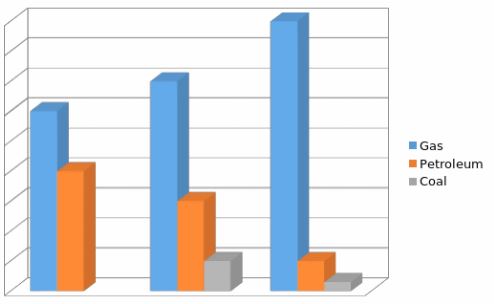Reducing energy usage
Figure1. Energy consumption in three days.

Figure 2. Different energy use in three days.
Figure 3. Purpose of the energy in three days.
Energy source, Reduction and efficiency
Gas is the major source of energy in my country with a contribution of about thirty nine percent of the total energy consumed. Coal provides thirty three percent of total electric energy which is more or less the same as gas (Baidya, 1984). Other energy sources include nuclear and renewable energy by twenty one and three percent respectively.
The development of the national grid led to a switch to electric power as the main source of energy. hydroelectric power and Wind power are yet to be utilized. Wind power is under development and could be the next appropriate source of power for the country since it has low pollution level which makes it more desirable than the above mentioned sources (Torleif et al., 1998).
I have had frequent visits to various power plants and have gained immense knowledge regarding power generation. I have also read vastly on the topic of energy. In addition, I have participated in a statistical data collection on energy usage from various neighborhoods in collaboration with various research company.
I have therefore been able to garner more knowledge regarding energy usage by many citizens countrywide. Although I don’t participate in these exercises more often, I have had the advantage to access the websites of these research companies. This opened an opportunity to be abreast with information about my country.
For effective usage of energy, I would contact a utility person to do insulation around my home. He/she would install insulating materials on the wall, floor and ceiling. I would also adopt the usage of gas furnaces and stoves. I would reduce water use in the house by saving warm water for reuse instead of pouring down the sink or bath tab. I would reuse packaging materials hence reducing house hold waste. In addition, I would purchase appliances with inbuilt energy savers.
Hindrances to Policy enforcement
There is greater hindrance to energy prospects by the government. Negative policies and laws imposed by the government have led to a lag in developmental projects such as wind power and petroleum search (Torleif et al., 1998). Lack of a corporate and financial structure that would aid in such development is also another hindrance.
Political goodwill has declined halting some of the major energy projects (Ballard &Fullerton, 1992). Legal frameworks are also difficult to work with since non -governmental organizations find it hard to access such developmental works in the country.
As an individual, it will be challenging to face the government and inform them to restrategize projects such as rural electrification. Quest to intervene for ecological factors such as biogas usage that would benefit the economy have been futile (Torleif et al., 1998). Disinclination is the main disease eating the government. The current policy is on environmental and trade with less emphasis on energy production. However, all hope is not gone since my country is still developing and hence it can trade in other energy sources it lacks with other countries such as the Arab countries.
References
Baidya, K. (1984). Shortage of firewood and eco-climate disaster Journal on environmental studies, 22,122-300.
Ballard C. L. and D. Fullerton (1992). Distortionary taxes and the provision of public goods, Journal of Economic Perspectives, Vol.6.
Knut, A. (1990). Refining Industry, cost, demands, and supply. Case study of oil product Market. Oxford: Oxford Institute of Energy Studies, Oxford University Press.
Torleif et al. (1998). Energy structures, the environment and the future. New York: Oxford University. (pp 23-25).